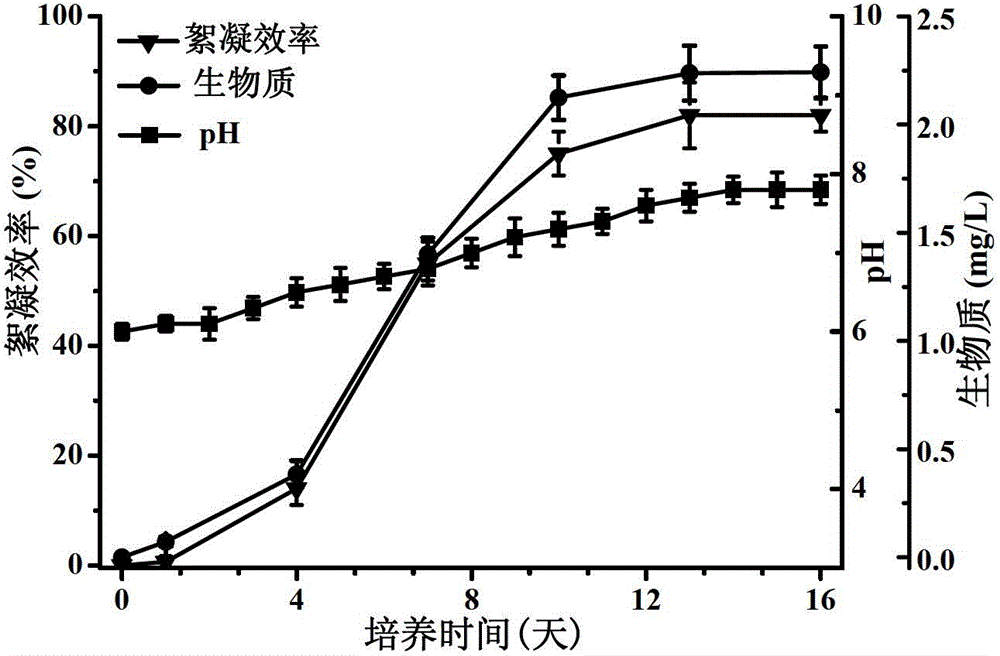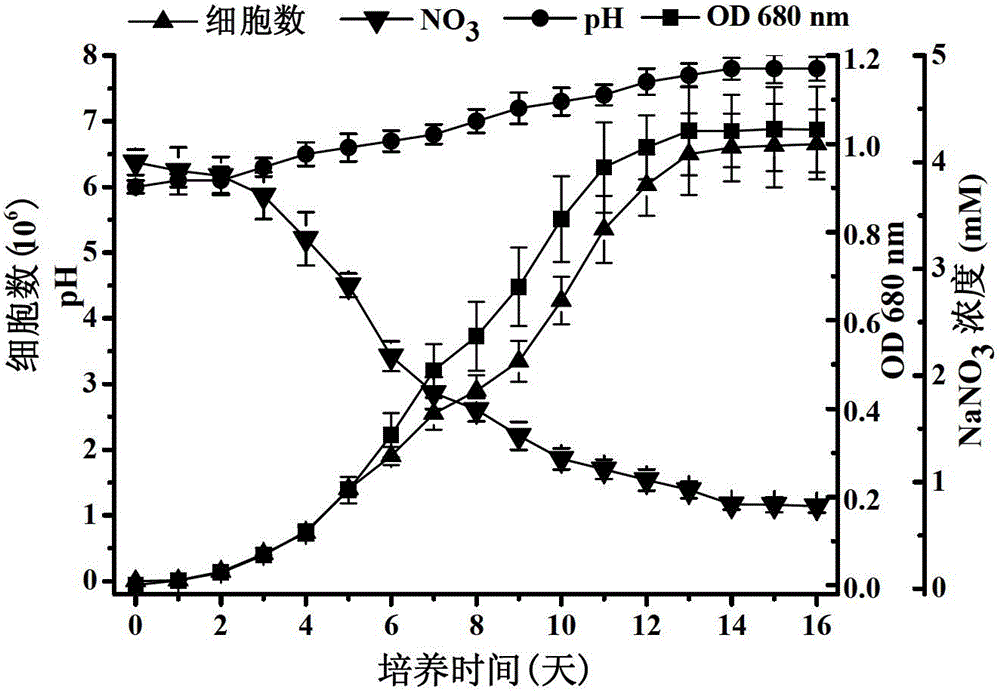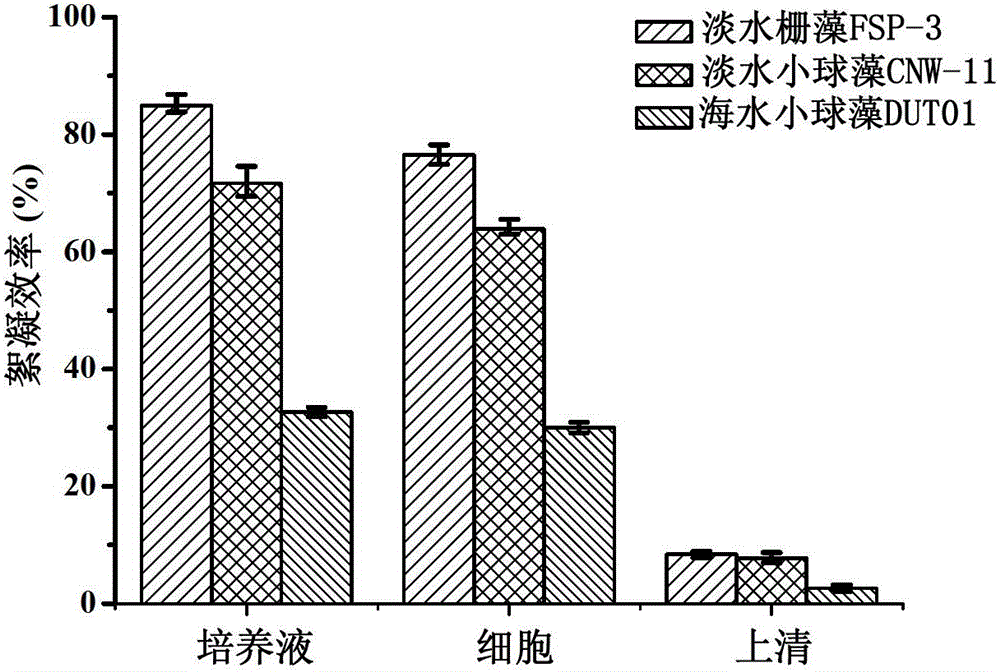Scenedesmus obliquus producing self-flocculation substance, and application of the same in microalgae harvesting
A technology of Scenedesmus obliquus and self-flocculation, which is applied in the field of microbial applications, can solve the problems of the filtration method depending on the algae cell size, environmental toxicity, and high cost of the air flotation method, and achieve good pH stability and thermal stability.
- Summary
- Abstract
- Description
- Claims
- Application Information
AI Technical Summary
Problems solved by technology
Method used
Image
Examples
Embodiment 1
[0032] Embodiment 1: The cultivation of the self-flocculating Scenedesmus obliquus of the present invention.
[0033] The self-flocculating Scenedesmus obliquus of the present invention is derived from the freshwater body in southern Taiwan, and the most suitable culture conditions are as follows: the pH of the initial medium is 6.0-6.2; the initial concentration is about 0.05-0.1 at O.D.685nm; the culture temperature is 28°C; the light intensity 60 μmol m -2 s -1 ; Photoperiod: 16h light culture, 8h dark culture. When cultured in the optimized DM liquid medium for 4-5 days, the algal cells are mostly in an aggregated state, and the size of the aggregates can be seen with the naked eye. After the 13-day culture medium is left still overnight, the algal cells aggregate together and settle into the Erlenmeyer flask At the bottom, the supernatant is clearly visible. Under the electron microscope, it was found that there was a membrane-like substance outside the algae cells tha...
Embodiment 2
[0033] The self-flocculating Scenedesmus obliquus of the present invention is derived from the freshwater body in southern Taiwan, and the most suitable culture conditions are as follows: the pH of the initial medium is 6.0-6.2; the initial concentration is about 0.05-0.1 at O.D.685nm; the culture temperature is 28°C; the light intensity 60 μmol m -2 s -1 ; Photoperiod: 16h light culture, 8h dark culture. When cultured in the optimized DM liquid medium for 4-5 days, the algal cells are mostly in an aggregated state, and the size of the aggregates can be seen with the naked eye. After the 13-day culture medium is left still overnight, the algal cells aggregate together and settle into the Erlenmeyer flask At the bottom, the supernatant is clearly visible. Under the electron microscope, it was found that there was a membrane-like substance outside the algae cells that wrapped the cells and adhered together ( figure 1) . Example 2: Genome extracted from Scenedesmus obliquus ...
Embodiment 3
[0047] Embodiment 3: the growth situation and the determination of biomass content of self-flocculation Scenedesmus oblique
[0048] The self-flocculating Scenedesmus obliquus was inoculated in the optimized DM liquid medium. After 5-13 days of culture, the algae grew rapidly, the number of algae cells increased rapidly, and the nitrogen content decreased significantly. The pH did not change much during the whole culture process, and the highest value was not More than 8, and no inorganic precipitates ( figure 2 ). After 16 days of cultivation, the protein content in the self-flocculating algae biomass can reach 28.4±1.3% of the dry weight, carbohydrates account for 25.3±1.0%, lipids account for 22.9±1.1%, and chlorophyll is as high as 13.0±0.6%, indicating that the algal strains of the present invention have Wide application prospects.
PUM
 Login to View More
Login to View More Abstract
Description
Claims
Application Information
 Login to View More
Login to View More - R&D
- Intellectual Property
- Life Sciences
- Materials
- Tech Scout
- Unparalleled Data Quality
- Higher Quality Content
- 60% Fewer Hallucinations
Browse by: Latest US Patents, China's latest patents, Technical Efficacy Thesaurus, Application Domain, Technology Topic, Popular Technical Reports.
© 2025 PatSnap. All rights reserved.Legal|Privacy policy|Modern Slavery Act Transparency Statement|Sitemap|About US| Contact US: help@patsnap.com



